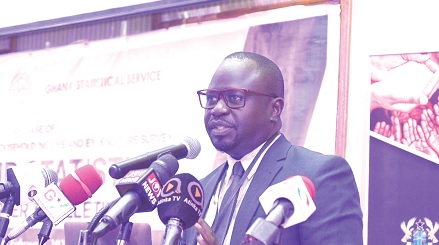adverts
More educated Ghanaians cannot find work to do, although they are available to work, a study by the Ghana Statistical Service (GSS) has revealed.
Almost a quarter of persons representing 22.3 per cent who experienced an unemployment spell for a 21-month period from January 2022 to September 2023 had completed tertiary education, while almost 48 per cent of persons experiencing unemployment spell had completed secondary education.
The GSS study defined unemployment spell as an uninterrupted period within which a person had stayed unemployed although he had the capacity and the willingness to work.
adverts
The Government Statistician, Professor Samuel Kobina Annim, presented the labour statistics contained in the Ghana 2023 Annual Household Income and Expenditure Survey (AHIES) quarter three labour statistics bulletin in Accra yesterday.
He said about 200,000 persons experienced an unemployment spell at least 12 months between the first quarter of 2022 and the third quarter of 2023.
It was highest among females, representing 11,540 persons, 18,086 persons in urban areas, 9,987 with secondary education, and among persons between 15 and 24 years of 9,341.
Prof. Annim said the survey tracked people who had been unemployed for two quarters, that is a six-month period, between the second quarter and third quarter of 2023.
It also tracked people who had been unemployed for nine months, from the first quarter of 2023 to third quarter of 2023, as well as those who had been unemployed for 21 months, from the first quarter of 2022 to third quarter of 2023.
The survey, the Government Statistician said, found out that the country had approximately 1.3 million people that had remained unemployed for a six-month period, thus in the second quarter and third quarter of 2023
“This number reduces to about 752,000 persons who as at the third quarter of 2023 had not been employed.
From the last quarter of 2022 to the end of the last quarter of 2023 were 191,000 persons who remained unemployed,” he indicated.
The survey
The AHIES is the country’s first nationally representative high-frequency household panel survey.
The 2023 third quarter survey provides quarterly information on key labour statistics for seven quarters from the first quarter of 2022 to third quarter of 2023.
The statistics were disaggregated by sex, type of locality, region and selected socio-demographic characteristics.
Youth unemployment
Youth unemployment, which was 1.3 million among people between the ages of 15 and 35 years, Prof. Annim said, contributed to more than three quarters of the total unemployment population of 1.85 million in the country.
“Under the survey, the population that we need to think about in terms of youth employment is a figure around 1.3 million.
This figure is an indication of a 14.6 percentage increase in the first three quarters of 2022 relative to the first three quarters of 2023,” he said.
Prof. Annim stressed that policymakers must direct their attention to that category of persons.
He said if the government was putting out any intervention, that was the population to target.
“So if there was an initiative to employ 200,000 youth, the figures should give a sense of how long it was going to take the country to get rid of the 1.3 million youth unemployed population,” he stated.
Unemployment rate
Prof. Annim said the year-on-year increase in the unemployment rate was highest in the Western Region, representing 7.8 per cent; Greater Accra, representing five per cent, and North East, representing 3.7 per cent.
The regions that recorded the highest year-on-year decline in unemployment rate were Northern, representing negative 6.3 per cent, Savannah, negative 2.9 per cent and Bono East, -2.9 per cent.
Prof. Annim said there was the need to address unemployment issues differently across the administrative regions, especially in the Greater Accra and Ashanti regions because they were the only two regions that consistently recorded unemployment rates higher than the national average during the seven quarters of the survey.
Youth not in employment, education or training (NEET) increased by 3.6 percentage points between the second and third quarters in 2023, reversing a downward trend in the previous four quarters.
Statistics on labour mobility from the fourth quarter of 2022 to the third quarter of 2023 indicated that among the 530,000 persons who transitioned from employment to unemployment status between the fourth quarter of 2022 to the first quarter of 2023, more than half (280,000) remained unemployed in the second quarter of 2023.
About 440,000 persons joined the labour force between the first quarter of 2023 and third quarter 2023 of which more than 240,000 persons, representing 60 per cent, were employed during the period.
Ensuring decent work
The Director of Research, Statistics and Information Management of the Ministry of Employment and Labour Relations (MELR), George Amoah, said the government had depended on such statistics for planning.
He indicated that the ministry would consider how best to use the report for the benefit of the country, especially ensuring decent work for the populace.


